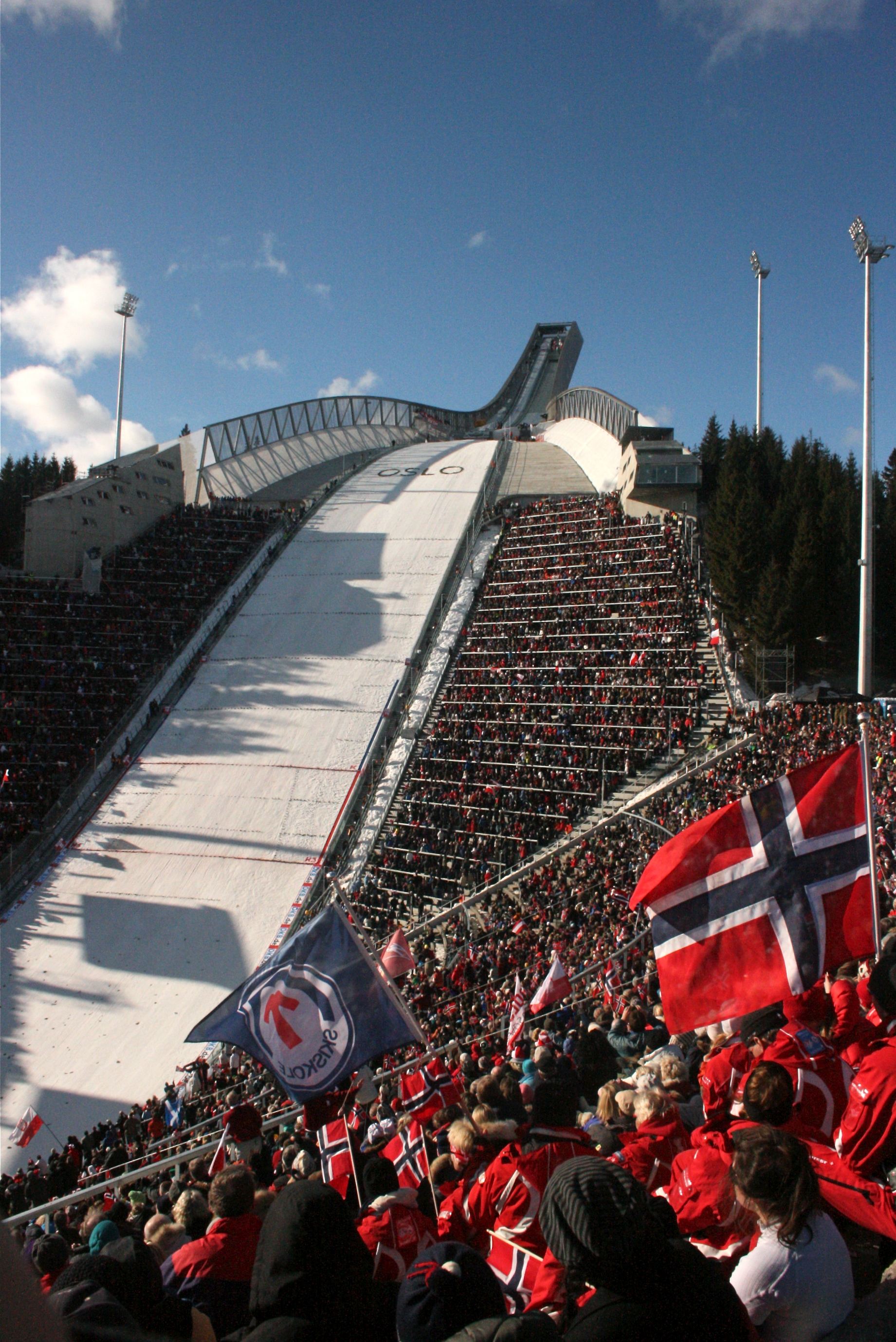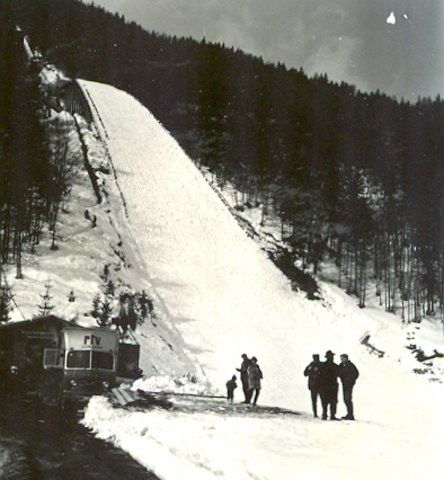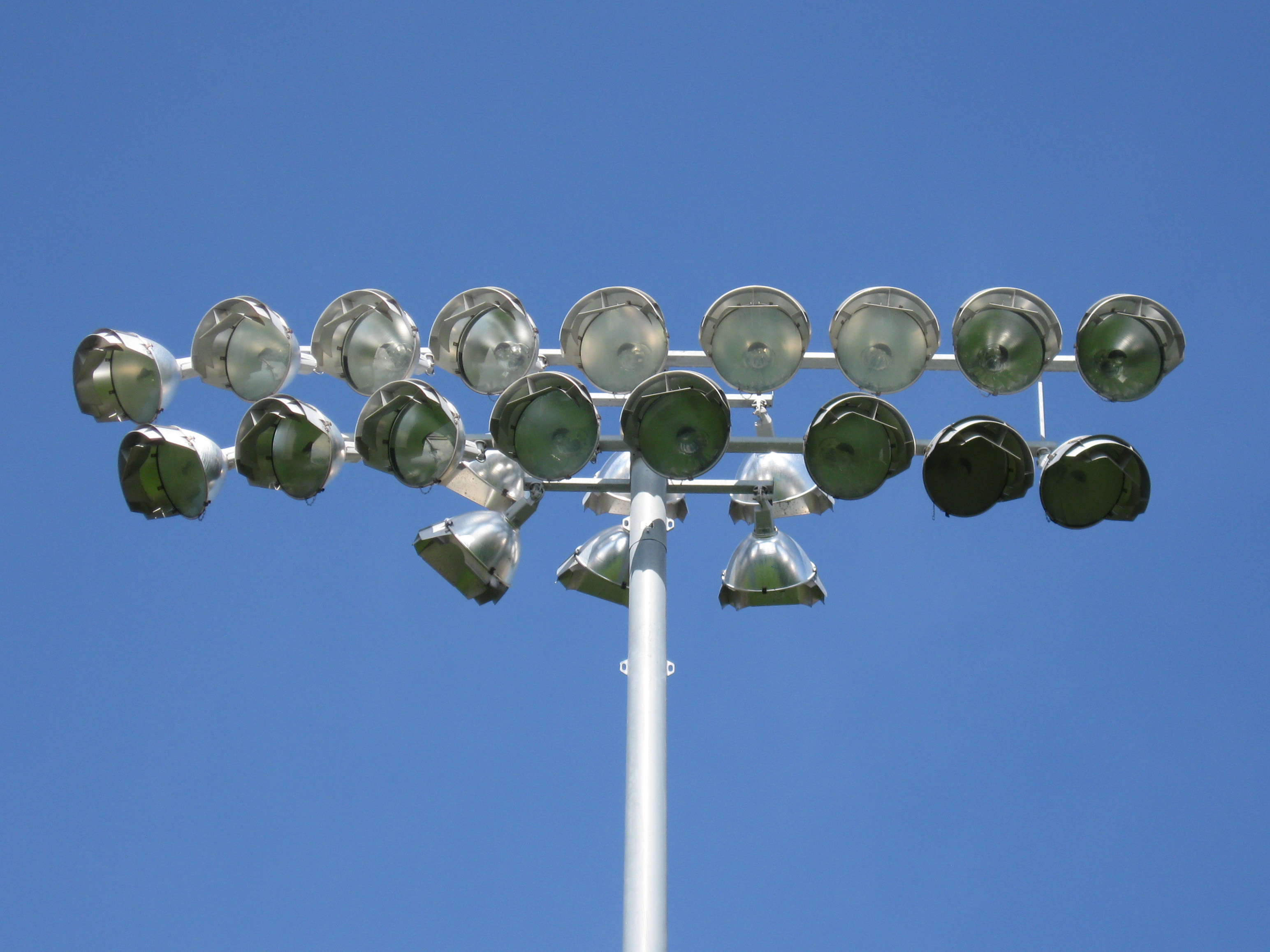|
Rødkleiva
Rødkleiva is a hill located in Nordmarka in Oslo, Norway. It was taken into use as a slalom hill in 1947 and was used for the combined event of the Holmenkollen Ski Festival eleven times between 1947 and 1963. It hosted the slalom events for the 1952 Winter Olympics, which saw a crowd of at least 25,000 spectators. The Olympic course was long and had a drop of . The course gradually fell into disrepair and was closed in 1988. The hill has several times been launched as a potential location for a ski jumping hill. The first idea came in 1912; later options to replace Holmenkollbakken resurfaced during the 1930s and the 1970s, but were quickly rejected. With the closing of Midtstubakken, Oslo's normal hill, in the late 1980s, Rødkleiva was again launched as a jumping hill. Vikersundbakken—Northern Europe's only ski flying hill—was in the late 1990s proposed replaced by a new hill in Rødkleiva. The plans received support from the Norwegian Ski Federation, but the municipal ... [...More Info...] [...Related Items...] OR: [Wikipedia] [Google] [Baidu] |
Holmenkollbakken
Holmenkollbakken is a large ski jumping hill located at Holmenkollen in Oslo, Norway. It has a hill size of HS134, a construction point of K-120, and a capacity for 70,000 spectators. Holmenkollen has hosted the Holmenkollen Ski Festival since 1892, which since 1980 have been part of the FIS Ski Jumping World Cup and 1983 the FIS Nordic Combined World Cup. It has also hosted the 1952 Winter Olympics and the FIS Nordic World Ski Championships in 1930, 1966, 1982 and 2011. The hill has been rebuilt 19 times; important upgrades include a stone take-off in 1910, an in-run superstructure in 1914, and a new superstructure in 1928. During the Second World War, the venue was used as a military installation, but upgraded in the late 1940s. Further expansions were made ahead of the 1966 and 1982 World Championships, as well as in 1991. Between 2008 and 2010, the entire structure was demolished and rebuilt. The hill record is held by Robert Johansson at 144.0 meters. The hill is part of Ho ... [...More Info...] [...Related Items...] OR: [Wikipedia] [Google] [Baidu] |
Norefjell Ski Resort
Norefjell Ski Resort ( no, Norefjell skisenter) is a mountain ski resort located in Krødsherad, Norway, on the mountainside of Norefjell. The venue for four Olympic alpine skiing events in 1952, it is located northwest of Oslo, 90 minutes away by vehicle. History Proposals for downhill skiing in Norefjell were first launched in the 1930s by a group of ski enthusiasts led by Per Fossum. They brought the issue to the attention of the Norwegian Ski Federation, who started negotiations with the landowners. A lease was signed in 1938 as the first such agreement made by the federation. The property was cleared during the summer and grooming started after the first snowfall. The management of the course was organized by Krødsherad IL with assistance from IF Liv for larger championships. The course was renovated slightly in 1947, with the curves being widened.Nordbye: 80 Oslo was awarded the 1952 Winter Olympics in June 1947, with Norefjell responsible for downhill and giant slalom. ... [...More Info...] [...Related Items...] OR: [Wikipedia] [Google] [Baidu] |
Alpine Skiing At The 1952 Winter Olympics
At the 1952 Winter Olympics in Oslo, Norway, the six alpine skiing events were held from Thursday, 14 February, to Wednesday, 20 February. The downhill and giant slalom events were held at Norefjell in Krødsherad, Buskerud, and the slalom events at Rødkleiva Rødkleiva is a hill located in Nordmarka in Oslo, Norway. It was taken into use as a slalom hill in 1947 and was used for the combined event of the Holmenkollen Ski Festival eleven times between 1947 and 1963. It hosted the slalom events for ... in Oslo. The giant slalom made its Olympic debut, and the Alpine skiing combined, combined event was dropped as an Olympic medal event for four decades, until Alpine skiing at the 1988 Winter Olympics, 1988. It returned as a medal event at the FIS Alpine World Ski Championships, World Championships two years later in FIS Alpine World Ski Championships 1954, 1954, and for the concurrent World Championships in Olympic years from Alpine skiing at the 1956 Winter Olympics#Worl ... [...More Info...] [...Related Items...] OR: [Wikipedia] [Google] [Baidu] |
1952 Winter Olympics
The 1952 Winter Olympics, officially known as the VI Olympic Winter Games ( no, De 6. olympiske vinterleker; nn, Dei 6. olympiske vinterleikane) and commonly known as Oslo 1952, was a winter multi-sport event held from 14 to 25 February 1952 in Oslo, the capital of Norway. Discussions about Oslo hosting the Winter Olympic Games began as early as 1935; the city was keen to host the 1948 Winter Olympics, but that was made impossible by World War II. Instead, Oslo won the right to host the 1952 Games in a contest that included Cortina d'Ampezzo in Italy and Lake Placid in the United States. All of the Olympic venues were in Oslo's metropolitan area, except for the alpine skiing events, which were held at Norefjell, from the capital. A new hotel was built for the press and dignitaries, along with three dormitories to house athletes and coaches, creating the first modern athlete's village. Oslo bore the financial burden of hosting the Games in return for the revenue they gen ... [...More Info...] [...Related Items...] OR: [Wikipedia] [Google] [Baidu] |
Ski Flying
Ski flying is a winter sport discipline derived from ski jumping, in which much greater distances can be achieved. It is a form of competitive individual Nordic skiing where athletes descend at high speed along a specially designed takeoff ramp using skis only; jump from the end of it with as much power as they can generate; then glide – or 'fly' – as far as possible down a steeply sloped hill; and ultimately land within a target zone in a stable manner. Points are awarded for distance and stylistic merit by five judges. Events are governed by the International Ski Federation (''Fédération Internationale de Ski''; FIS). The rules and scoring in ski flying are mostly the same as they are in ski jumping, and events under the discipline are usually contested as part of the FIS Ski Jumping World Cup season, but the hills (of which there are only five remaining, all in Europe) are constructed to different specifications in order to enable jumps of up to 66% longer in distan ... [...More Info...] [...Related Items...] OR: [Wikipedia] [Google] [Baidu] |
Norwegian Krone
The krone (, abbreviation: kr (also NKr for distinction); code: NOK), plural ''kroner'', is currency of the Kingdom of Norway (including Svalbard). Traditionally known as the Norwegian crown in English. It is nominally subdivided into 100 ''øre'', although the last coins denominated in øre were withdrawn in 2012. The krone was the thirteenth-most-traded currency in the world by value in April 2010, down three positions from 2007. The Norwegian krone is also informally accepted in many shops in Sweden and Finland that are close to the Norwegian border, and also in some shops in the Danish ferry ports of Hirtshals and Frederikshavn. Norwegians spent 14.1 billion NOK on border shopping in 2015 compared to 10.5 billion NOK spent in 2010. Border shopping is a fairly common practice amongst Norwegians, though it is seldom done on impulse. Money is spent mainly on food articles, alcohol, and tobacco, in that order, usually in bulk or large quantities. This is due to considerably ... [...More Info...] [...Related Items...] OR: [Wikipedia] [Google] [Baidu] |
Holmenkollen Line
The Holmenkollen Line ( no, Holmenkollbanen) is an Oslo Metro line which runs between Majorstuen and Nordmarka in Oslo, Norway. Operating as Metro Line 1, it is the route with the fewest passengers and the only one still to have level crossings and short station platforms. The line runs mostly through residential areas of detached houses, and the upper parts of the line principally serve the recreational area of Nordmarka. Holmenkollen Station is located close to Holmenkollen National Arena which hosts international Nordic skiing tournaments. Voksenkollen Station is not far from Oslo Vinterpark (Winter) and the Oslo Sommerpark (Summer). The line is the oldest one on the metro system, having been opened as a light railway in 1898 by the Holmenkolbanen company. Originally it ran for from Majorstuen Station to Besserud. In 1916, the line was extended to Tryvann, with the last being used for freight only. In 1928, the city terminus was moved to the underground Nationaltheatr ... [...More Info...] [...Related Items...] OR: [Wikipedia] [Google] [Baidu] |
Lillevann (station)
Lillevann is a station on the Holmenkollen Line (Line 1) on the Oslo Metro. The station is located between Skogen and Voksenkollen, at an altitude of above mean sea level. The station was opened on 16 May 1916 with the extension of the line from Besserud, but the station building is older. That building was built in 1898 on an estate at Besserud, but then moved to Lillevann. The architect was Paul Due. Lillevann can claim at least two superlatives. The station is the least-used on the entire metro system, with only 49 passengers embarking and disembarking per day in 2003. (''Oslo Sporveier satser der det er kunder'') , Septe ... [...More Info...] [...Related Items...] OR: [Wikipedia] [Google] [Baidu] |
Above Mean Sea Level
Height above mean sea level is a measure of the vertical distance (height, elevation or altitude) of a location in reference to a historic mean sea level taken as a vertical datum. In geodesy, it is formalized as ''orthometric heights''. The combination of unit of measurement and the physical quantity (height) is called "metres above mean sea level" in the metric system, while in United States customary and imperial units it would be called "feet above mean sea level". Mean sea levels are affected by climate change and other factors and change over time. For this and other reasons, recorded measurements of elevation above sea level at a reference time in history might differ from the actual elevation of a given location over sea level at a given moment. Uses Metres above sea level is the standard measurement of the elevation or altitude of: * Geographic locations such as towns, mountains and other landmarks. * The top of buildings and other structures. * Flying objects such ... [...More Info...] [...Related Items...] OR: [Wikipedia] [Google] [Baidu] |
Downhill (ski Competition)
Downhill is a form of alpine skiing competition. Whereas the other alpine skiing events (Slalom skiing, slalom, Giant slalom skiing, giant slalom, Super Giant Slalom skiing, super giant slalom, and alpine skiing combined, combined) emphasize turning and technique, downhill emphasizes "the six components of technique, courage, speed, risk, physical condition and judgement", according to the International Ski Federation, FIS "International Ski Competition Rules (ICR)".. Speeds of up to are common in international competition. Athletes must have an aerodynamically efficient tuck position to minimize drag coefficient, drag and increase speed. The term, "downhill skiing", is also used as a synonym for alpine skiing as a recreational activity. History The rules for downhill skiing competitions were originally developed by Sir Arnold Lunn for the 1921 British National Ski Championships. A speed of was first achieved by Johan Clarey at the 2013 Alpine Skiing World Cup, 2013 Lauberho ... [...More Info...] [...Related Items...] OR: [Wikipedia] [Google] [Baidu] |
Floodlights (sport)
A floodlight is a broad-beamed, high-intensity artificial light. They are often used to illuminate outdoor playing fields while an outdoor sports event is being held during low-light conditions. More focused kinds are often used as a stage lighting instrument in live performances such as concerts and plays. In the top tiers of many professional sports, it is a requirement for stadiums to have floodlights to allow games to be scheduled outside daylight hours. Evening or night matches may suit spectators who have work or other commitments earlier in the day, and enable television broadcasts during lucrative primetime hours. Some sports grounds which do not have permanent floodlights installed may make use of portable temporary ones instead. Many larger floodlights (see bottom picture) will have gantries for bulb changing and maintenance. These will usually be able to accommodate one or two maintenance workers. Types The most common type of floodlight is the metal-halide ... [...More Info...] [...Related Items...] OR: [Wikipedia] [Google] [Baidu] |
YMCA
YMCA, sometimes regionally called the Y, is a worldwide youth organization based in Geneva, Switzerland, with more than 64 million beneficiaries in 120 countries. It was founded on 6 June 1844 by George Williams in London, originally as the Young Men's Christian Association, and aims to put Christian values into practice by developing a healthy "body, mind, and spirit". From its inception, it grew rapidly and ultimately became a worldwide movement founded on the principles of muscular Christianity. Local YMCAs deliver projects and services focused on youth development through a wide variety of youth activities, including providing athletic facilities, holding classes for a wide variety of skills, promoting Christianity, and humanitarian work. YMCA is a non-governmental federation, with each independent local YMCA affiliated with its national organization. The national organizations, in turn, are part of both an Area Alliance (Europe, Asia Pacific, the Middle East, Af ... [...More Info...] [...Related Items...] OR: [Wikipedia] [Google] [Baidu] |







